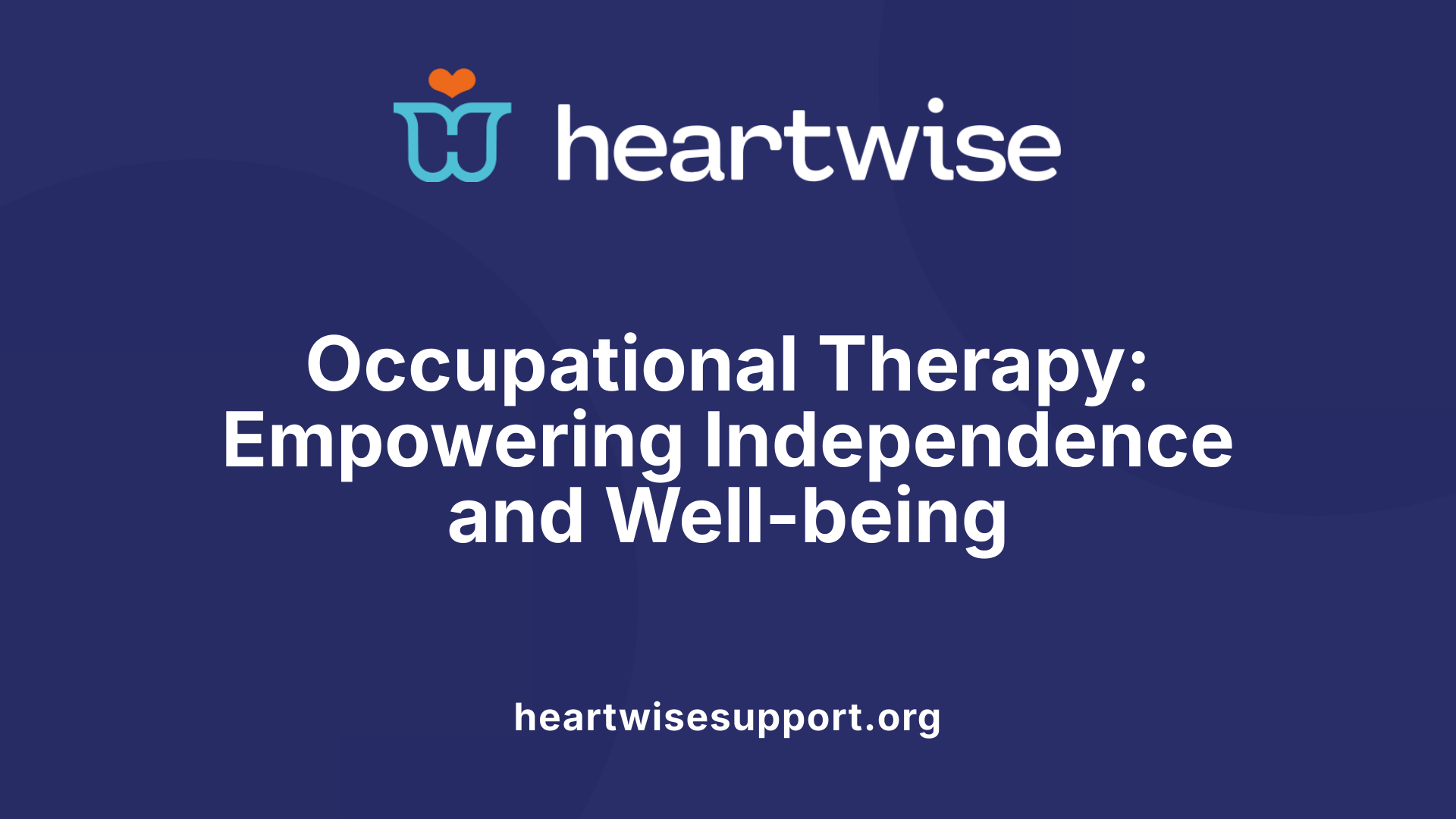Unlocking Daily Skills for Better Living
Occupational therapy plays a crucial role in enhancing individuals' ability to perform daily tasks independently, thereby improving their quality of life. From children to seniors, tailored interventions focus on developing essential skills, adapting environments, and using assistive tools to promote safety, confidence, and self-reliance. This article explores various facets of occupational therapy for daily living skill development, addressing assessment methods, targeted activities, age-specific approaches, and long-term benefits.
Understanding Activities of Daily Living (ADLs) and Their Significance

What are Activities of Daily Living (ADLs) in occupational therapy?
Activities of Daily Living (ADLs) are essential routines that enable individuals to care for themselves independently. These fundamental self-care tasks include activities such as eating, toileting, bathing, grooming, dressing, and mobility. Both basic self-care and more complex tasks, known as instrumental activities of daily living (IADLs), are encompassed within this concept.
In occupational therapy, assessing and improving performance in ADLs is crucial. Therapists work with clients of all ages, from children with cerebral palsy to older adults recovering from injury, to enhance their ability to perform these tasks. This process promotes autonomy and improves overall quality of life.
Basic self-care activities included in ADLs
ADLs comprise the core activities necessary for daily independence:
- Dressing
- Bathing and personal hygiene
- Eating and drinking
- Toileting and managing continence
- Moving around (mobility and transfers)
Therapists often evaluate skills in these areas to identify challenges and develop personalized intervention strategies. Using adaptive tools like grab bars, dressing aids, and utensil holders can help clients regain or maintain independence.
Assessment tools for evaluating ADLs
To determine an individual's functional status, occupational therapists utilize various assessment tools. Some of the most common include:
| Tool Name | Purpose | Application |
|---|---|---|
| Katz Index | Measures independence in basic ADLs | Hospital and long-term care settings |
| Lawton IADL Scale | Assesses instrumental activities like shopping and managing finances | Community-dwelling adults |
| Canadian Occupational Performance Measure (COPM) | Identifies client-perceived problems in daily activities | Customized to individual goals |
| GMFCS | Classifies gross motor function in children with mobility issues | Pediatric rehabilitation |
These evaluations help therapists identify specific difficulties, plan appropriate treatments, and monitor progress.
Strategies used by occupational therapists to improve ADL performance
Therapists employ various techniques to enhance ADL skills, including:
- Environmental modifications: Installing grab bars, rearranging furniture, and ensuring safe layouts.
- Adaptive equipment: Using long-handled tools, dressing aids, and mobility devices.
- Task analysis: Breaking down complex activities into simple, manageable steps tailored to the client's abilities.
- Skill training: Practicing routines like dressing, grooming, and cooking with guidance and repetition.
- Cognitive support: Employing memory aids and problem-solving exercises for individuals with cognitive impairments.
Implementing these strategies enables individuals to perform daily tasks with greater independence, fostering confidence and safety in their environments.
Instrumental Activities of Daily Living (IADLs): Expanding Independence

What are Instrumental Activities of Daily Living (IADLs) in occupational therapy?
Instrumental Activities of Daily Living (IADLs) are more complex tasks necessary for maintaining independence in daily life. Unlike basic self-care activities such as bathing or dressing, IADLs include preparing meals, managing finances, taking medications, cleaning, shopping, using transportation, communication, and household maintenance.
These activities typically demand higher-level cognitive skills like problem-solving, planning, and organizational abilities. They also require coordination, dexterity, and sometimes physical strength, making them essential for safe, autonomous living.
Occupational therapists play a vital role in evaluating and supporting individuals in performing IADLs. They develop personalized strategies, recommend adaptive tools, and suggest environmental modifications to help individuals overcome challenges. Enhancing ability in IADLs significantly impacts overall independence, self-confidence, and quality of life.
Cognitive and physical skills involved in IADLs
Successful performance of IADLs depends on various cognitive skills, including memory, attention, problem-solving, and decision-making. Physical skills such as strength, coordination, and fine motor control are also crucial.
For example, managing finances requires memory and attention to detail, while cooking involves both cognitive planning and physical coordination. Impairments in any of these areas can hinder a person's ability to carry out IADLs safely.
Assessment and support strategies for IADLs
Occupational therapists utilize standardized tools like the Lawton Instrumental Activities of Daily Living Scale to evaluate an individual's ability to perform these tasks. The assessment identifies specific areas of difficulty and guides intervention planning.
Support strategies include:
- Teaching new techniques or routines
- Introducing adaptive equipment such as jar openers or step stools
- Modifying the home environment for better accessibility
- Providing cognitive rehabilitation exercises
Training may also involve caregivers to ensure ongoing support and safety.
Importance of IADLs in maintaining independence
Maintaining proficiency in IADLs is crucial for aging adults, individuals with disabilities, or those recovering from illness or injury. Being able to manage these activities supports living independently and reduces reliance on caregivers or institutional care.
Problems with IADLs can lead to safety risks, hospitalization, or institutional placement if not addressed promptly. Therefore, occupational therapy interventions emphasizing IADLs are integral in promoting long-term independence and enhancing overall well-being.
| Aspect | Activities | Skills Involved | Support Methods |
|---|---|---|---|
| Basic Activities | Dressing, bathing, toileting | Fine motor skills, strength, balance | Adaptive tools, environmental modifications |
| Instrumental Activities | Cooking, cleaning, shopping | Cognitive, physical coordination | Task simplification, assistive devices |
Supporting individuals in mastering their IADLs improves their ability to live independently, fostering confidence and a better quality of life.
Targeted Daily Living Skills and Therapeutic Techniques

What are common daily living skills targeted by occupational therapy?
Occupational therapy focuses on improving a wide array of daily tasks to help individuals maintain independence and safety in their daily lives. For seniors, these skills include fundamental activities such as personal hygiene routines—bathing, grooming, brushing teeth—dressing, eating, managing continence, and mobility.
Therapists conduct assessments to identify specific needs and challenges each person faces. Based on these evaluations, they develop personalized programs that often involve adaptive tools, environmental modifications, and targeted exercises.
Therapeutic interventions include teaching proper swallowing techniques to reduce risk during eating and introducing adapted utensils and kitchen tools. Additionally, therapists may suggest modifications like grab bars, raised toilet seats, or shower chairs to make home environments safer and more accessible.
Overall, occupational therapy helps individuals perform these essential activities more safely and efficiently. This tailored approach enhances their confidence, promotes independence, and contributes to a better quality of life.
Assessment and Personalization of Occupational Therapy Interventions

How do occupational therapists assess and improve daily living skills?
Occupational therapists carry out thorough evaluations to understand an individual's capacity for daily activities. They begin by reviewing medical histories, conducting interviews with clients and their families, and observing how clients perform tasks such as dressing, cooking, and grooming. To standardize this process, therapists often use assessment tools like the Katz Index of Independence in ADL and the Lawton IADL Scale. These instruments help identify strengths and areas needing support.
During assessments, therapists pay close attention to physical, cognitive, sensory, and emotional factors affecting daily tasks. They observe clients’ movement patterns, coordination, memory, and safety awareness. Based on these insights, therapists develop personalized treatment plans tailored to each person's unique needs and goals.
The intervention strategies include task simplification, cognitive rehab, and environmental modifications. For example, they might suggest adaptive tools such as grab bars, dressing aids, or specialized utensils to enhance safety and independence. Therapists also train clients in the proper use of assistive devices, offer safety tips to prevent falls or accidents, and modify home setups to optimize accessibility.
Environmental changes and aid tools
Making adjustments to the living environment is a crucial part of therapy. Installing grab bars, rearranging furniture, and ensuring sufficient lighting help reduce fall risks. Adaptive equipment like shower chairs, raised toilet seats, and long-handled tools support independent performance of daily tasks.
Cognitive, motor, and sensory strategies employed
Interventions often target improvement in motor skills, such as strengthening and coordination exercises, to facilitate independent movement. Cognitive strategies might include memory aids or problem-solving practices to support routines like medication management. Sensory strategies focus on compensating for visual or sensory deficits, ensuring clients can safely and effectively navigate their environments. These comprehensive, tailored approaches help clients regain confidence and maximize their independence in daily life activities.
The Role and Impact of Occupational Therapy in Daily Life

What is the role of occupational therapy in promoting independence in daily activities?
Occupational therapy (OT) is fundamental in helping individuals maintain or regain their ability to perform essential daily activities. By thoroughly assessing each person’s unique needs, therapists create personalized plans that target specific challenges in self-care, household chores, or employment tasks.
OT focuses on improving skills like hand strength, coordination, memory, and problem-solving. For example, they might teach seniors how to use adaptive tools such as long-handled shoe horns or shower chairs, which make daily routines easier and safer.
Environmental modifications are key aspects of OT. Therapists can recommend installing grab bars, improving lighting, or rearranging furniture to prevent falls and enhance safety. For children, strategies might include breaking complex tasks into smaller, manageable steps or using visual cues.
Through education, training, and the use of assistive devices, occupational therapists empower individuals and their caregivers. This approach not only enhances independence but also boosts confidence and emotional well-being.
In short, OT helps people participate fully in daily life by fostering skills, ensuring safety, and making necessary adaptations. Whether at home, in healthcare settings, or within communities, occupational therapy provides the tools and support needed for individuals to live more self-reliant and fulfilling lives.
How do environmental adaptations and assistive technologies support independence?
Adapting home environments with assistive technologies is a core part of occupational therapy. Installing grab bars in bathrooms, using raised toilet seats, or setting up accessible storage areas can significantly reduce risks. Assistive devices like reachers, dressing aids, or ergonomic kitchen tools help individuals perform tasks with less effort and more safety.
Therapists also recommend and train users on how to incorporate tools such as shower chairs, long-handled sponges, and adaptive utensils for eating. These modifications help manage physical limitations and promote dignity.
What are the long-term benefits of occupational therapy?
Engaging in OT activities yields lasting advantages. Clients often experience increased independence, improved physical and cognitive skills, and a higher overall quality of life. This can result in fewer accidents like falls, decreased need for long-term care, and reduced healthcare costs.
Additionally, participating in occupational therapy fosters emotional resilience and social participation. For children, mastering daily skills builds confidence and self-esteem, supporting their development.
Over time, these benefits contribute to healthier, safer communities and more positive life experiences for individuals across all age groups.
| Topic | Detail | Further Insights |
|---|---|---|
| Promoting independence in daily routines | Personal assessments and tailored interventions | Focuses on physical, cognitive, and emotional skill improvements |
| Environmental modifications | Home safety adaptations and assistive devices | Reduce hazards and facilitate easier task performance |
| Long-term effects | Improved safety, confidence, and reduced healthcare costs | Enhances quality of life by fostering sustainable independence |
| Activities addressed | Self-care, household chores, work, and play | OT programs are adaptable for individuals in diverse settings |
Occupational therapy's comprehensive approach ensures that individuals gain the skills, confidence, and safe environments necessary for living independently, ultimately enriching their everyday lives.
Fostering Self-Reliance for a Better Quality of Life
Occupational therapy is a vital field dedicated to developing and strengthening the everyday skills necessary for independent living. Through comprehensive assessments, personalized strategies, environmental modifications, and adaptive technologies, occupational therapists enable individuals of all ages to overcome physical, cognitive, and emotional barriers. The focus on activities like ADLs and IADLs not only enhances safety and functionality but also boosts confidence and emotional well-being. The collaborative, patient-centered approach ensures that each person receives interventions tailored to their unique needs, fostering long-term independence. Emphasizing early intervention, family involvement, and multidisciplinary teamwork, occupational therapy continually contributes to improving quality of life and promoting self-sufficiency, empowering individuals to lead satisfying, independent lives.
References
- Occupational Therapy For Activities Of Daily Living - Sagewood
- Daily Living Skills - Monkey Mouths
- OT Activities for Adults: Enhancing Daily Living Skills
- Activities of Daily Living - StatPearls - NCBI Bookshelf
- Occupational Therapy Techniques to Improve Daily Living Skills
- The Role of Occupational Therapy in Enhancing Daily Living Skills
- Occupational Therapy - Skills for the job of living - Cascade Health
- Occupational Therapy: Enhancing Daily Living Skills & Independence
- How Occupational Therapy Helps People Regain Independence











